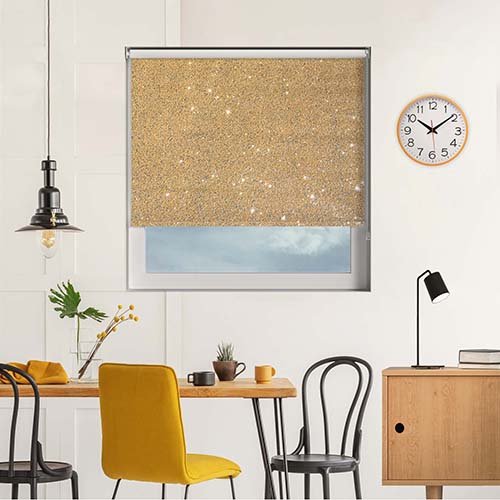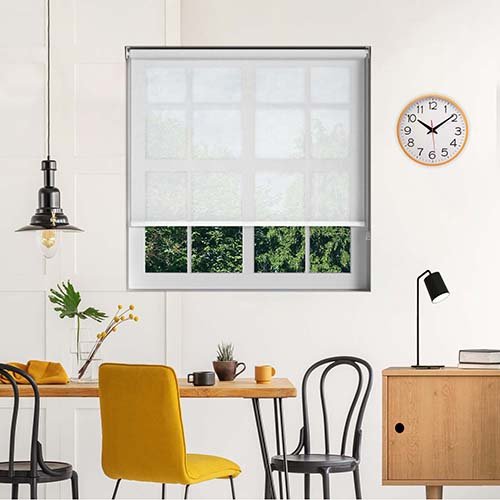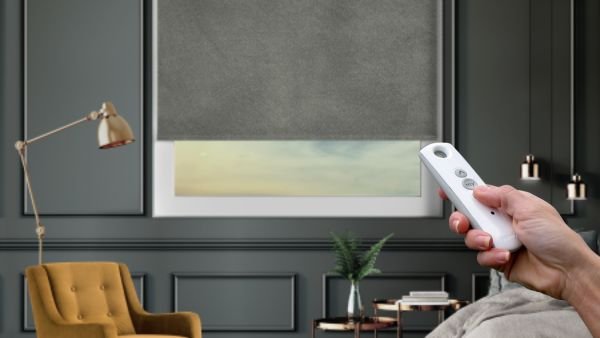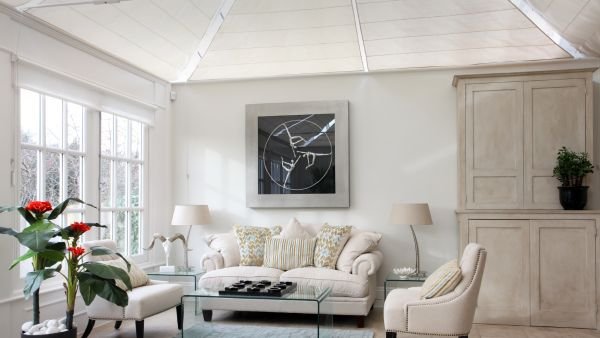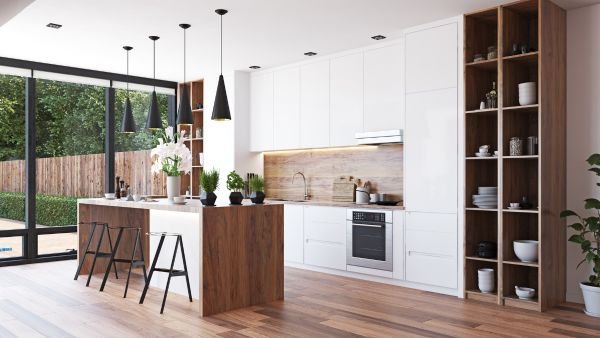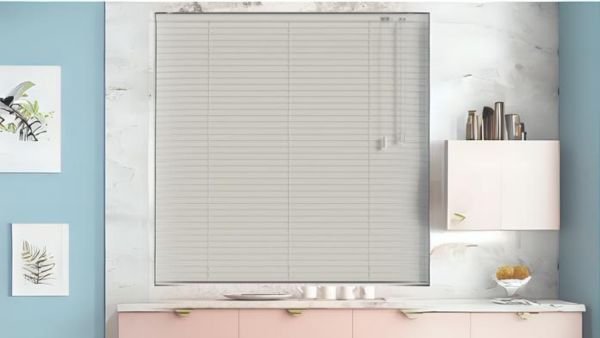Everything You Need to Know About Horizontal Blinds
If you're exploring window treatments, you must’ve come across horizontal blinds: the ones with the slats that can tilt to adjust light and privacy.
But it’s easy to feel lost about their design, how they operate, or if they’ll fit your style. These details can make or break your decision while picking blinds.
In this guide, we’ll break down everything you need to know about horizontal blinds — how they’re designed, the materials they’re made from, and how they function in different settings.
So, keep reading and know everything about horizontal blinds!
How do Horizontal Blinds Look?
Horizontal blinds, also called Venetian or slatted blinds, consist of lateral slats connected together by strings or cords. These slats can be tilted open or closed to control light and privacy.
The slats are made from materials like wood, faux wood, aluminum, or vinyl, to give them a sleek and modern look that can complement various interior styles.
The slats of horizontal blinds are usually flat and rectangular, with widths ranging from narrow to wide, depending on the style and the amount of light control desired.
When the blinds are fully open, the slats stack neatly at the top to allow a clear view through the window. When closed, the slats overlap slightly, creating a smooth, continuous surface that blocks light and provides privacy.
The Headrail
The headrail is the top part of the blinds, where the slats are attached. It houses the mechanisms that control the raising, lowering, and tilting of the slats. The headrail is covered by a valance, a decorative piece that hides the hardware and gives the blinds a finished look.
Cords or Tapes
Each slat in these blinds is connected by cords or tapes, which run vertically along the length of the blinds. These cords allow you to adjust the angle of the slats, giving you control over the amount of light entering the room. Some horizontal blinds use ladder tapes instead of standard cords, which add a decorative element.
The Bottom Rail
The bottom rail is the bar at the bottom of the blinds which helps weigh down the slats, keeping them aligned and in place when the blinds are closed. The bottom rail also lets the blinds hang straight, ensuring a neat and orderly appearance.
Types of Horizontal Blinds
Horizontal blinds come in multiple styles and material variations to perfectly fit your windows. Here are the top types of these blinds:
Mini Blinds
Mini blinds are identified by their smaller slats, about one inch wide. These small slats make them a great option for smaller windows or doors where standard-sized slats might look too bulky.
Mini blinds are often made from aluminum or vinyl, which makes them lightweight and easy to clean. Their compact design also provides better light control, as you can tilt the smaller slats more precisely to manage the light entering the room.
Micro Blinds
Micro blinds take the concept of mini blinds a step further by using even narrower slats, around less than half an inch wide. These are often used in commercial settings or spaces with very narrow windows, where larger slats would be impractical.
The slim profile of micro blinds makes them almost disappear when fully open to give an unobstructed view. Despite their small size, micro blinds are just as functional as larger blinds, providing effective light control and privacy.
Wood Blinds
Wood blinds bring a warm, natural feel to any room. They are made from various types of wood, such as oak, cherry, or basswood, each offering its exclusive grain and color.
The rich, natural tones of wood can complement different interior styles, from rustic to modern. These blinds are also known for their durability, as well as their ability to insulate against heat and cold.
Faux Wood Blinds
Faux wood blinds offer the look of real wood but with the added benefits of durability and moisture resistance.
Faux wood blinds are made from composite materials like PVC or vinyl, so they are less likely to warp, crack, or fade. Therefore, they are a smart option for areas with high humidity, such as bathrooms and kitchens.
These blinds are also easier to clean than real wood ones, as they require only a quick wipe down with a damp cloth to remove dust and grime.
Faux wood blinds come in various finishes, some closely mimic the grain and texture of real wood, so you can achieve the same aesthetic at a lower cost.
Aluminum Blinds
Aluminum blinds are a common choice for residential and commercial settings due to their lightweight, durable construction. They are also resistant to moisture, so they work well in bathrooms, kitchens, and other areas where humidity might be a concern.
Aluminum blinds are also easy to clean and maintain, as they don’t absorb dirt, and you can quickly wipe them.
Plus, aluminum blinds are highly functional as they offer excellent light control and privacy. Their slim profile makes them suitable for most window sizes, and they’re often used in offices due to their professional appearance.
Operating Horizontal Blinds
Not sure how to open and close slatted blinds? Here’s a simple explanation:
Lifting and Lowering
A cord lock mechanism located inside the headrail, which is the top part of the blinds, controls the lifting and lowering of horizontal blinds.
Pulling the lift cord releases the cord lock mechanism, allowing the slats to move freely. To raise the blinds, pull the cord downward. As you do this, the cord wraps around a drum inside the headrail, lifting the bottom rail of the blinds and stacking the slats neatly at the top.
The more you pull the cord, the higher the blinds go. To lower them, you pull the cord to release the lock and then slowly let the cord slide through your fingers so that the slats descend.
Once the blinds are at your desired height, you can secure them by pulling the cord toward the outer edge of the blinds, which engages the cord lock mechanism.
Tilting
Tilting the slats of horizontal blinds is needed for controlling the amount of light and privacy in a room; you manage this by a set of gears located inside the headrail.
Depending on the design of the blinds, the tilt mechanism is operated by either a tilt wand or a tilt cord. If the blinds have a tilt wand, you twist it to adjust the angle of the slats.
As you turn the wand, the gears inside the headrail engage and rotate a rod that runs the length of the headrail. This rod is connected to the ladders, which hold the slats. The rotation of the rod then causes the ladders to tilt, which in turn adjusts the angle of the slats.
For blinds with a tilt cord, the mechanism works a little differently. Instead of twisting a wand, you pull one of the two cords to change the angle of the slats.
Pulling one cord tilts the slats upward while pulling the other cord tilts them downward. The cords are connected to a similar gear system that adjusts the position of the slats.
How Good is Light Control and Privacy of Horizontal Blinds?
The adjustable slats in horizontal blinds can help fine-tune the amount of light that enters a room. You can let in just a little light or block it almost entirely by tilting the slats. This level of control is ideal for rooms where you want to reduce glare without completely darkening the space, like living rooms or offices.
If we talk about privacy, horizontal blinds perform well. When the slats are fully closed, they create a solid barrier that stops people from seeing into the room, so they are, undoubtedly, a suitable option for bedrooms or bathrooms.
Get the Best Horizontal Blinds to Make Your Place Look Chic
Opting for top-quality slatted blinds means you’ll save yourself from the hassle of tricky installations and enjoy smooth operation.
Good-quality blinds will help you achieve excellent light control and privacy, making your living space more comfortable and secure.
If you want to choose the best lateral blinds, Life Style Blinds offers a ton of horizontal blinds that combine durability with ease of use.
Our products are designed to provide you with the best experience, so your investment is worth every penny.
Take a look at the selection and see how easy it is to improve your home with blinds that truly work for you.
FAQs
Are horizontal blinds energy-efficient?
Yes, horizontal blinds can be energy efficient. When fully closed, they help reduce heat gain in the summer and minimize heat loss in the winter by creating a barrier between the window and the room. To maximize energy efficiency, consider choosing blinds with a thicker material or adding a liner for additional insulation.
How do I clean horizontal blinds?
For regular dusting, use a microfiber cloth or a duster. For a deeper clean, wipe the slats with a damp cloth and mild detergent. If your blinds are made of wood, avoid using excessive water; instead, use a wood-safe cleaner. Faux wood and aluminum blinds can be cleaned with water without the risk of damage.
Can horizontal blinds be motorized?
Yes, many horizontal blinds can be motorized for added convenience. Motorized blinds let you control the lifting, lowering, and tilting of the slats with a remote or even through a smartphone app. This is particularly useful for hard-to-reach windows or for people looking to automate their home.







































































